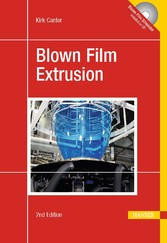Suchen und Finden
Service
Blown Film Extrusion - An Introduction
Kirk Cantor
Verlag Carl Hanser Fachbuchverlag, 2011
ISBN 9783446428195 , 181 Seiten
2. Auflage
Format PDF, OL
Kopierschutz Wasserzeichen
Geräte
Acknowledgements
6
Contents
8
Introduction
12
1 Materials for Blown Film
16
1.1 Polymers
16
1.1.1 Polyethylene (PE)
17
1.1.2 Low Density Polyethylene (LDPE)
17
1.1.3 High Density Polyethylene (HDPE)
19
1.1.4 Linear Low Density Polyethylene (LLDPE)
20
1.1.5 Metallocene Polyethylene (mPE)
21
1.1.6 Polypropylene (PP)
21
1.1.7 Polystyrene (PS)
22
1.1.8 Ethylene Vinyl Acetate (EVA)
23
1.1.9 Ethylene Vinyl Alcohol (EVOH)
24
1.1.10 Polyvinyl Chloride (PVC)
24
1.1.11 Polyvinylidene Chloride (PVDC)
25
1.1.12 Polyamide (PA)
25
1.1.13 Polyurethane (PU)
26
1.2 Additives
26
1.2.1 Antiblocking Agents
27
1.2.2 Antioxidants
27
1.2.3 Antistatic Agents
27
1.2.4 Colorants
28
1.2.5 Lubricants
29
1.2.6 Reinforcements and Fillers
29
1.2.7 Stabilizers
31
1.2.8 Tackifiers
31
2 Extrusion Overview
34
2.1 Extruder Hardware Systems
34
2.1.1 Drive System
36
2.1.1.1 Motor
36
2.1.1.2 Speed Reducer
36
2.1.1.3 Thrust Bearing
37
2.1.2 Feed System
39
2.1.3 Screw/Barrel System
41
2.1.3.1 Screw
41
2.1.3.2 Barrel
43
2.1.4 Head/Die System
44
2.1.4.1 Head Assembly
45
2.1.4.2 Adapter
45
2.1.4.3 Breaker Plate
45
2.1.4.4 Melt Filter
46
2.1.4.5 Die
48
2.1.5 Instrumentation and Control System
49
2.1.5.1 Temperature Control
50
2.1.5.2 Head Pressure
53
2.1.5.3 Motor Current
54
2.2 Extrusion Functional Zones
55
2.2.1 Solids Conveying
56
2.2.1.1 Gravity-Induced Region
56
2.2.1.2 Drag-Induced Region
57
2.2.2 Melting
58
2.2.3 Melt Pumping
60
2.2.4 Mixing
62
2.2.4.1 Distributive Mixing
63
2.2.4.2 Dispersive Mixing
63
2.2.4.3 Mixing Devices
64
2.2.5 Degassing
66
2.2.6 Die Forming
67
3 Hardware for Blown Film
72
3.1 Upstream Components
73
3.2 Grooved Feed Throat
75
3.3 Screws for Blown Film Extrusion
77
3.4 Blown Film Dies
78
3.5 Bubble Geometry
83
3.6 Bubble Cooling
86
3.7 Bubble Stabilization
91
3.8 Collapsing Frames
91
3.9 Haul-off
92
3.10 Winders
94
3.11 Film Treatment
95
3.12 Line Control
96
4 Processing
102
4.1 Process Variables vs. Bubble Geometry
103
4.2 Characteristic Bubble Ratios
105
4.3 Process/Structure/Property Relationships
108
4.4 Double Bubble Processing
110
5 Coextrusion
112
5.1 Dies
113
5.2 Interfacial Instabilities
115
5.3 Product Applications
116
5.3.1 Breathable Packaging
116
5.3.2 Shrink Film
117
5.3.3 High Barrier Film
118
6 Film Properties
120
6.1 Tensile Strength (ASTM D882)
122
6.2 Elongation (ASTM D882)
124
6.3 Tear Strength (ASTM D1004, ASTM D1922, and D1938)
124
6.4 Impact Resistance (ASTM D1709, D3420, and D4272)
126
6.5 Blocking Load (ASTM D3354) and Coefficient of Friction (ASTM D1894)
127
6.6 Gel (Fisheye) Count (ASTM D3351 and D3596)
128
6.7 Low Temperature Brittleness (ASTM D1790)
128
6.8 Gloss (ASTM D2457)
129
6.9 Transparency (ASTM D1746)
129
6.10 Haze (ASTM D1003)
130
6.11 Density (ASTM D1505)
130
6.12 Melt Index (ASTM D1238)
131
6.13 Viscosity by Capillary Rheometry (ASTM D3835)
133
7 Troubleshooting
136
7.1 Extruder Problems
137
7.1.1 Surging
137
7.1.2 High Melt Temperature
138
7.1.3 Excessive Cooling
140
7.1.4 Low Output
141
7.2 Film Problems
142
7.2.1 Melt Fracture
142
7.2.2 Thickness Variation
143
7.2.3 Die Lines
147
7.2.4 Gels
148
7.2.5 Low Mechanical Properties
149
7.2.6 Poor Optical Properties
150
7.2.7 Wrinkles
151
Appendix A: The Blown Film Extrusion Simulator
152
A.1 Introduction
152
A.2 Installation
153
A.3 Running the Program
154
A.4 Worksheet
161
Appendix B: Useful Equations
164
References
172
Subject Index
176
Service
Shop













